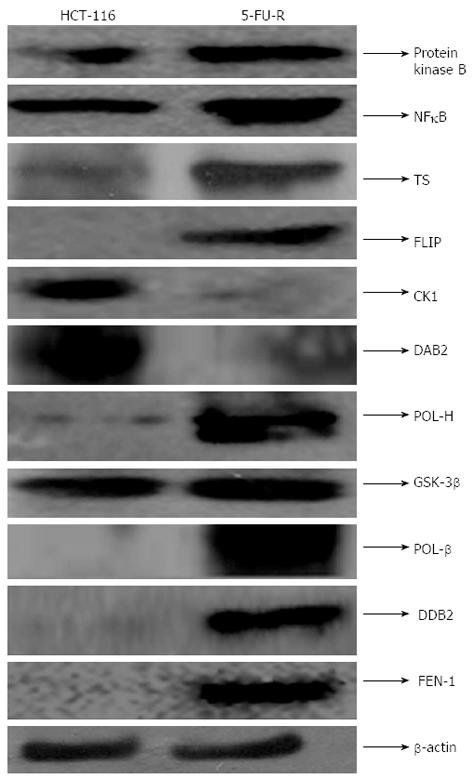Copyright
©2013 Baishideng Publishing Group Co.
World J Gastroenterol. Nov 14, 2013; 19(42): 7374-7388
Published online Nov 14, 2013. doi: 10.3748/wjg.v19.i42.7374
Published online Nov 14, 2013. doi: 10.3748/wjg.v19.i42.7374
Figure 4 Characterization of 5-fluorouracil-resistant cells.
The cell lysates of HCT-116 and 5-FU-R cells were immunoblotted using specific antibody. The lower panel shows the expression of β-actin, which was the loading control (to ensure the same amount of protein loaded in each lane). Data are the representation of one of the replicates of three different experiments. CK1: Casein kinase 1; FLIP: FLICE-like inhibitory protein; NFκB: nuclear factor κB; POL-β: DNA polymerase beta; POLH: DNA polymerase eta; protein Flap FEN1: Endonuclease 1; DDB2: DNA damage-binding protein 2; 5-FU: 5-fluorouracil; Res: Resveratrol; BCNU: 1,3-Bis(2-chloroethyl)-1-nitrosourea; TS: Thymidylate synthase.
- Citation: Das D, Preet R, Mohapatra P, Satapathy SR, Kundu CN. 1,3-Bis(2-chloroethyl)-1-nitrosourea enhances the inhibitory effect of Resveratrol on 5-fluorouracil sensitive/resistant colon cancer cells. World J Gastroenterol 2013; 19(42): 7374-7388
- URL: https://www.wjgnet.com/1007-9327/full/v19/i42/7374.htm
- DOI: https://dx.doi.org/10.3748/wjg.v19.i42.7374









